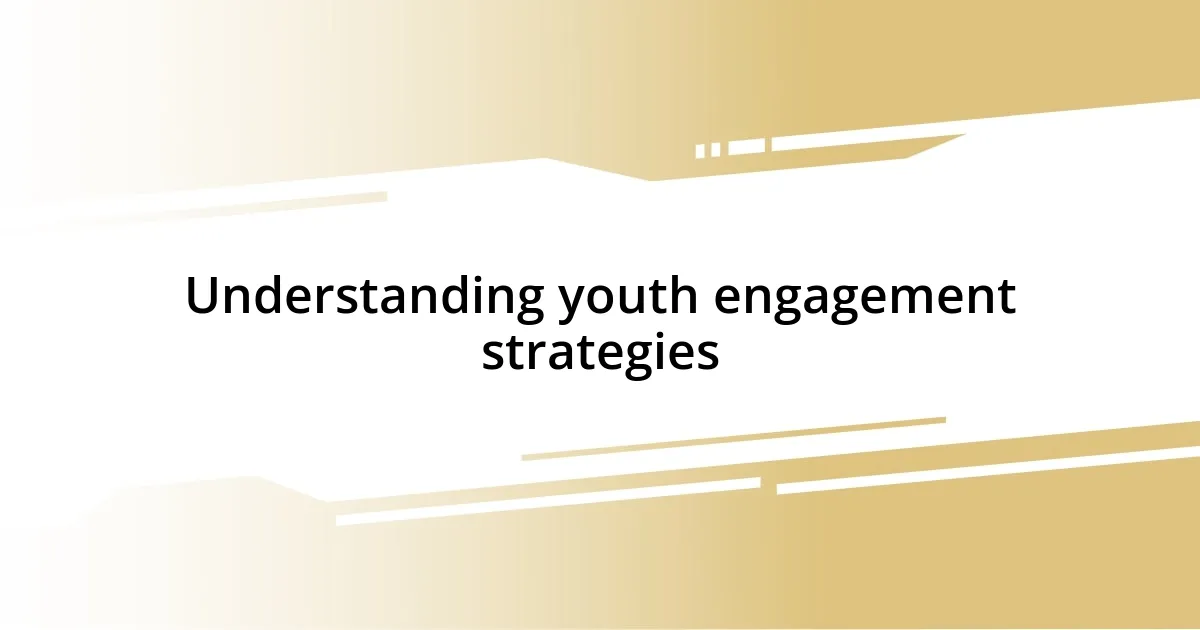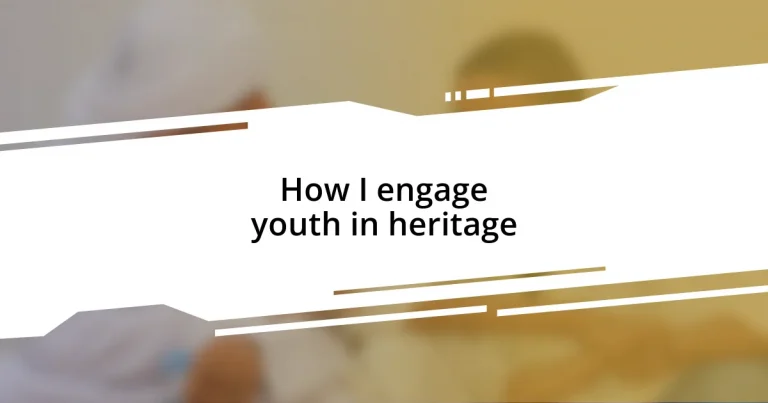Key takeaways:
- Engaging youth involves recognizing their diverse backgrounds and providing inclusive platforms for storytelling and expression.
- Utilizing technology, such as social media and virtual reality, enhances youth participation in heritage awareness and fosters community connection.
- Interactive programs like workshops, story circles, and collaborative projects can transform passive learning into active engagement with heritage.
- Supporting youth-led initiatives encourages ownership and innovation in cultural preservation, allowing them to lead and create meaningful projects.

Understanding youth engagement strategies
One crucial aspect of engaging youth is recognizing their diverse interests and backgrounds. I remember when I volunteered at a local heritage festival, and we invited youth to share their personal stories related to their cultural backgrounds. Seeing their faces light up when they connected with others over shared experiences really underscored how powerful storytelling can be in building engagement.
Creating an inclusive environment is essential as well. I once organized a workshop where young people could express their opinions on local heritage sites through art. The energy in that room was palpable! It made me realize how significant it is to provide platforms for youth to voice their ideas. This kind of involvement fosters a sense of ownership, transforming passive participants into active contributors.
Finally, using technology is an effective way to draw in younger audiences. While working on a digital project that showcased local history, I utilized social media platforms to encourage interaction. I was amazed at the engagement levels – sometimes, I pondered whether it would have been as effective without the allure of technology. It goes to show that blending traditional methods with modern tools can create dynamic youth engagement strategies.

Utilizing technology for heritage awareness
Utilizing technology effectively can illuminate heritage in ways that resonate deeply with youth. I once participated in a virtual reality experience that transported users back to historical events in our local area. It was incredible to witness young people’s eyes widen in awe as they “walked” through past lives and learned stories firsthand. This immersive approach sparked meaningful conversations about identity and our shared history, proving that technology can bridge the gap between past and present.
Social media is another powerful tool for heritage awareness. When I launched an Instagram campaign highlighting hidden gems in our community’s heritage, I was struck by the response. Youth began tagging their friends and sharing personal stories about their connections to these places. It became a community-driven narrative, showcasing how technology can amplify voices and cultivate a collective pride in our heritage. The excitement was palpable; social media turned into a platform for discovery and connection.
Furthermore, gamification has emerged as a creative method to engage youth with their heritage. I remember organizing a local scavenger hunt that required participants to use an app to solve clues related to historical sites. The thrill of competition, combined with the joy of learning, encouraged many to explore parts of our heritage they hadn’t appreciated before. It was enlightening to observe how playful engagement could lead to deeper understandings of local history and culture.
| Technology Tool | Effectiveness for Heritage Awareness |
|---|---|
| Virtual Reality | Immersive experiences that create emotional connections. |
| Social Media | Encourages sharing and community engagement around heritage stories. |
| Gamification | Transforms learning into fun, interactive experiences. |

Creating interactive heritage programs
Creating interactive heritage programs means integrating hands-on activities that resonate with young people’s everyday experiences. I’ve seen firsthand how effective workshops that incorporate crafts and games have been in capturing their interest. For instance, during a community heritage day, I helped facilitate a storytelling session where participants could create their own cultural artifacts. The pride on their faces as they shared their creations was priceless; it highlighted how active participation fosters a connection to heritage that passive learning simply cannot achieve.
When designing these programs, consider the following engaging components:
- Workshops: Hands-on activities like pottery or weaving that allow youth to create and learn.
- Story Circles: Encouraging sharing personal narratives related to heritage can create a supportive community atmosphere.
- Collaborative Projects: Partnering with local artists to create murals or installations can infuse youth creativity into heritage expressions.
- Exploratory Field Trips: Organizing visits to local historical sites, where youth can engage in scavenger hunts, adds excitement and adventure to learning.
- Interactive Exhibitions: Setting up exhibits that require youth participation through digital storytelling can make heritage feel more relevant and accessible.
These elements can transform passive interactions into memorable experiences, making heritage both fun and educational. Each time I’ve watched youth dive into these activities, it reaffirmed my belief that engagement should never feel distant; it must invite personal investment and genuine curiosity.

Leveraging community partnerships for involvement
Building strong community partnerships is essential for engaging youth in heritage initiatives. I remember collaborating with a local youth organization to host a heritage festival. The excitement was contagious as we worked together to bring in various displays and performances that truly resonated with young people. It was a rewarding experience to see them not only participating but also leading activities that showcased their unique cultural perspectives.
Additionally, partnering with schools can create avenues for learning that extend beyond the classroom. When I approached a nearby high school with a proposal for a project on local history, their enthusiastic response surprised me. Students organized interviews with elders in the community, allowing them to connect generations through stories. This partnership didn’t just enhance their understanding of heritage; it fostered a sense of responsibility to preserve it.
I find that local businesses often have untapped potential for collaboration, too. One time, I teamed up with a local café to host “Heritage Nights,” where youth could share their cultural recipes and culinary traditions. The café became a vibrant hub of activity, as conversations and laughter filled the air. Such partnerships not only draw in diverse audiences but also create a shared investment in heritage that resonates deeply within the community. Have you considered how your local networks could enhance youth involvement in heritage?

Promoting youth-led heritage projects
Promoting youth-led heritage projects can be incredibly powerful in fostering a sense of ownership among young people. I recall a time when a group of enthusiastic teens approached me with an idea to create a documentary about their hometown’s history. Their passion was infectious—it was remarkable to witness how much they learned about their heritage while taking charge of the project. Watching them collaborate with local historians and artists not only strengthened their skills but also deepened their connection to the community. Have you ever seen youth rally around a cause? It’s a sight that reminds us how naturally they embrace leadership when given the chance.
In another instance, I supported a youth-led project aimed at reviving a local festival that celebrated cultural traditions. The planning meetings were filled with vibrant discussions, laughter, and creativity. One of the teens suggested incorporating modern elements, like a social media campaign to engage others. I was amazed by their fresh perspective—they weren’t just focused on the past but were also eager to innovate. This blend of respect for heritage and forward-thinking is what truly enhances youth participation. How often do we overlook the ideas that young people can bring to the table?
It’s crucial to provide the resources and guidance that youth need to succeed in these projects. I once mentored a team that wanted to create a mural depicting the history of immigration in our city. They had the talent, but they struggled with funding and logistics. By connecting them with local businesses for sponsorship and organizing workshops for mural techniques, I saw their vision materialize on the walls of our community center. It taught me that when young people have the right support, their initiatives can become impactful celebrations of heritage that resonate with everyone. How can we create more pathways for youth to lead in preserving and promoting our shared heritage?














